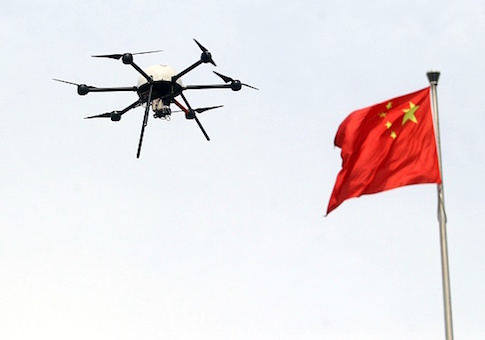A new report reveals how the Chinese military uses unmanned drones as a means of power projection and surveillance in the hotly contested South and East China Seas.
The report, released Monday by the Project 2049 Institute, offers "a field guide to Chinese UAVs/UCAVs operating in the disputed East and South China Seas."
China, the report claims, is currently undergoing a "drone boom," driven both by heavy investment in the Chinese drone industry and by the sometimes-illegal acquisition of foreign drone technology. The Department of Defense projects that China will produce tens of thousands of drones, worth more than $10 billion, by 2023.
China is increasingly deploying these drones in disputed areas over which it claims sovereignty. Drones have been sighted in the East China Sea—where China claims territory also claimed by Japan and Taiwan—and the South China Sea—where China contests sovereignty with a number of other countries, including Taiwan, Malaysia, and Vietnam.
Drone sightings in the disputed territories are now common enough that it has become necessary to offer a guide for identification by the average seaman. "Education and discussion of drones can no longer be the exclusive domain of theorists or high-level officers," the report argues.
Identification is especially important because of the lack of international rules governing the treatment of drones, including in areas where sovereignty is contested. Drones in the contested zones have already made political trouble, including the Chinese military’s theft of a U.S. underwater drone in 2016 and the alleged buzzing of Philippine Navy ships by Chinese drones.
The report documents four drones known to be in use by the People's Liberation Army Air Force: the S-100, ASN-209, BZK-005, and GJ-1. Three of the drones are Chinese-produced while one, the S-100, is made by Schiebel, an Austrian firm.
The drones discussed fill a variety of roles, from surveillance drones such as the S-100 to primarily military drones like the GJ-1 (more popularly known as the Wing Loong I model). All four are known to operate across the contested territory of the South and East China Seas, although the land-launched ASN-209 so far is only known to operate over the East China Sea. The drones vary in effective range, with the S-100 covering just small areas while the GJ-1 can reach as far north as Japan and as far south as Malaysia.
One limiting factor facing Chinese power projection is the inability of current drones to runway launch from aboard the Chinese Navy's sole aircraft carrier. This limits the BKZ-005, primarily used for surveillance, to being launched from land. Smaller drones such as the S-100 are vertical takeoff and landing (VTOL) models, and so do not face the same problem. Additionally, drones can be launched from Chinese-controlled artificial islands in the contested seas.
Although standard aerial drones make up the bulk of Chinese drone power in the contest territory, other kinds of drones are an important component of regional strategic considerations. Late last month, China deployed dozens of underwater drones, ostensibly for scientific research, in a move that Newsweek said could leave the U.S. Navy "dead in the water." At least one report suggested the PLA is considering adding drone swarm technology to its arsenal.
China is also exporting military drones to a number of other countries. It was announced in March that China Aerospace Science and Technology Corporation would construct a new factory in Saudi Arabia to construct drones for the Saudi Arabian air force.
